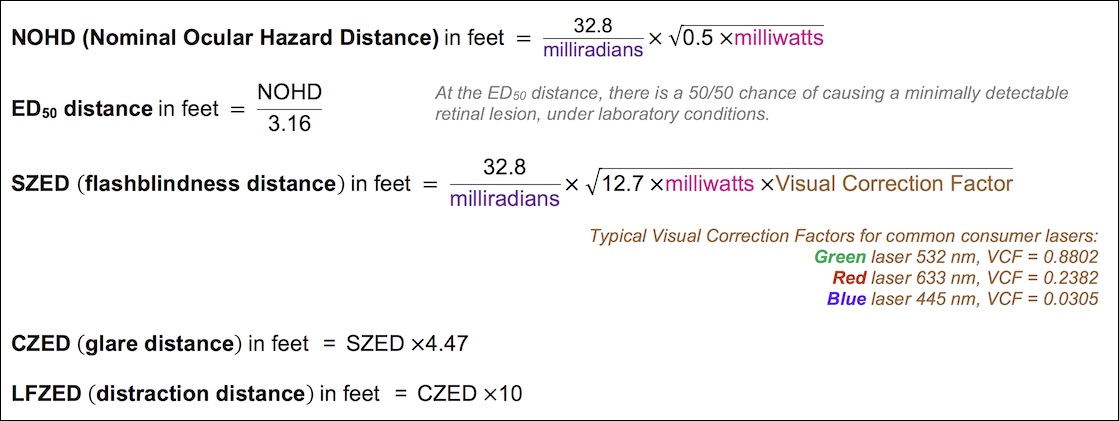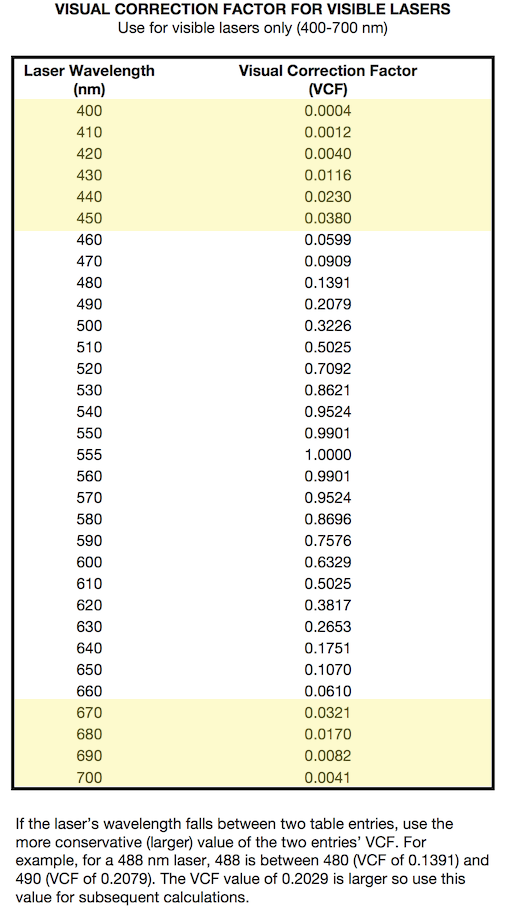Home
A comprehensive resource for safe and responsible laser use

NOTE: This page refers to FAA Advisory Circular AC 70-1. In March 2019, this version was updated with the new AC 70-1A. The "1A" version fixed the problems below. Use AC 70-1A or later (1B, 1C, etc.) so that you do not need the corrections. This webpage has been left for historical purposes. Our current advise for AC 70-1A is here.
Corrections and advice for FAA Advisory Circular AC 70-1
The U.S. Federal Aviation Administration requests that those who use lasers outdoors fill out forms found in FAA Advisory Circular 70-1. If you need to fill out AC 70-1, you should find the information below to be helpful.
Background to the corrections
As of this writing (March 2017), the most recent version of AC 70-1 is dated December 30 2004. Unfortunately, there are some errors and unclear sections in this version.
- In 2014, FAA requested an update to 70-1, which was done by selected members of the SAE G10T committee. This committee in the early 2000’s had originally developed what became AC 70-1.
- While FAA never officially adopted the 2014 changes, the information is scientifically correct and is reflected in current standards such as ANSI Z136.1 and Z136.6 that are recognized by FAA. On page 6 of AC 70-1, the “Alternative analysis” paragraph explicitly states that 1) the AC 70-1 form and tables are necessarily simplified, and 2) it is acceptable to use an alternative analysis based on the ANSI Z136 series of standards.
- So FAA should not have any objections to submissions based on the 2014 SAE G10T update, which in turn is based on the most recent ANSI standard.
Incorrect blocks in Single Pulse column
On the Laser Configurations form, gray blocks are used to indicate areas where data is “not applicable.” The user should not put anything in a gray block. Unfortunately, the FAA form has two gray blocks in the wrong position (plus there is a typo).
The current, incorrect form is shown at top. At the bottom are the corrections requested in 2005.
As the corrected form indicates, the two gray blocks in the Single Pulse column should be moved down. Also, the typo “Divergency” should be corrected to “Divergence”.

In the box for item 5, Calculated Distances, the phrase “than NOHD” is repeated twice. This is an error. In the image below, the repeat has been crossed out in red.

New information on MPEs and pulsed lasers, page 7
The information below shows the new 2014 material from the SAE G10T experts in boldface.
(a) MAXIMUM PERMISSIBLE EXPOSURE (MPE) CALCULATIONS - Provide the Maximum Permissible Exposure (MPE) calculation results in the applicable block. For convenience, a simplified, conservative method is provided in Tables 1-4 of this document. If you require less conservative levels, use the American National Standards Institute (ANSI) Z136 series of standards or other established methods. Both the methods and calculations must be documented. Unintentional exposure on aircraft is expected to be no more than 0.25 s due to natural relative motion between the beam and aircraft related to wind and other stabilization issues. The following analysis applies to laser wavelengths between 400 nm and 1050 nm for exposures less than 0.25 s. Additional analysis techniques can be found in the ANSI Z136 series of standards.
Continuous Wave (CW) - A laser that produces a continuous (non-pulsed) output for a period > 0.25 seconds is regarded as a CW laser. Use Table 2 to find the MPE. Fill in the “MPE” block in the Continuous Wave column.
Pulsed – Pulsed lasers can produce hazards greater than CW lasers with the same average power. Lasers that produce recurring pulses of energy (PRF) at a frequency greater than 13 kilohertz (kHz) may be treated the same as CW lasers. However, the applicable MPE for lasers that are pulsed at less than 13 kilohertz is based on an individual pulse. Following are the simplified methods for determining the MPE for:
(1) Ultraviolet and infrared wavelengths greater than 1050 nm: Reference the American National Standards Institute ANSI Z136 series.
(2) Visible and infrared wavelengths up to 1050 nm: For PRF greater than 13 kHz, use Table 2 to determine the MPE in W/cm‑2. For PRF less than 13 kHz, use Table 1 to determine the MPE in J/cm-2. Fill in the appropriate “MPE” block in the Pulsed column.
(b) VISUAL EFFECT CALCULATIONS - If the laser has no wavelengths in the visible range (400-700 nm), enter “N/A (non- visible laser)” in these blocks and go to the next section. For visible lasers, the FAA is concerned about beams that are eye-safe (below the MPE) but are bright enough to distract aircrews. The FAA has therefore established “Sensitive,” “Critical” and “Laser-Free” areas where aircraft should not be exposed to light above 100µW/cm2, 5µW/cm2, and 50nW/cm2 respectively. Because apparent brightness varies with wavelength – green is more visible than red or blue – a visual effect correction factor can be applied if desired. This has the effect of allowing more power for red and blue beams than for green beams. For any visible laser, you must submit Visual Effect Calculations:
First, determine the Pre-Corrected Power.
(1) Pulsed – For single pulsed lasers, multiply the Pulse Energy (J) by 4. For repetitively pulsed lasers multiply the pulse energy by the PRF. Enter this power in the form for Pre-Corrected Power.
Due to this change in how pulsed lasers are evaluated, Table 3 (MPEPRF Limits) is no longer needed.
Correction to equations on page 10
On page 10, the following Exposure Level equations are given:
EL = 1.0×10-8 W/cm2 (100 µW/cm2) when calculating slant range for Sensitive Zone Exposure Distance (SZED)
EL = 5.0×10-7 W/cm2 (5 µW/cm2) when calculating slant range for Critical Zone Exposure Distance (CZED)
EL = 5.0×10-10 W/cm2 (50 nW/cm2) when calculating slant range for Laser Free Exposure Distance (LFED)
However, the exponents are incorrect. This means the wrong values would be used to calculate the SZED, CZED and LFED exposure levels. Here are the equations with the correct exponents:
EL = 1.0×10-4 W/cm2 (100 µW/cm2) when calculating slant range for Sensitive Zone Exposure Distance (SZED)
EL = 5.0×10-6 W/cm2 (5 µW/cm2) when calculating slant range for Critical Zone Exposure Distance (CZED)
EL = 5.0×10-8 W/cm2 (50 nW/cm2) when calculating slant range for Laser Free Exposure Distance (LFED)
These are the SZED, CZED and LFED exposure levels without exponents:
ELSZED = 0.0001 W/cm2 or 0.1 mW/cm2 (W = watts, mW = milliwatts)
ELCZED = 0.000005 W/cm2 or 0.005 mW/cm2
ELLFED = 0.00000005 W/cm2 or 0.00005 mW/cm2
Simplified calculations for visible CW laser light, page 10
If you are using continuous-wave lasers in the visible light range (generally 400 to 700 nanometers), you can use the online laser hazard distance calculator.
You can also use the simplified equations below; they give the same results as the online calculator. These equations have been double- and triple-checked. They are correct for visible CW laser light at aviation distances of hundreds or thousands of feet.

Note: These calculations make some simplifying assumptions which are valid for continuous-wave visible lasers at aircraft distances. The SZED differs from the formula found in FAA Advisory Circular 70-1 by converting watts to milliwatts. This in turn makes the constant under the square root to be “12.7” and not the “1.27” found in Advisory Circular 70-1.
More information and examples can be found on the Laser safety calculations page.
No exponents in Table 5, page 15
Here is a version of Table 5 that has no exponents. This makes the VCF numbers easier to use — you do not have to “get the exponent right.”

Caution if the Visual Correction Factor is less than 0.0395
If the VCF is less than 0.0395 — the yellow areas marked above — then you need to double-check to see if any of the visual interference distance values (SZED, CZED or LFZED) are less than the NOHD. If they are less than the NOHD, then use the NOHD value instead.
This is to avoid cases such as a blue or red beam which appears so dim to the eye that it has a short visual interference distance, but can still be an eye hazard to a greater distance. The goal is to not allow a person to be exposed at a distance shorter than the NOHD.
Take for example a deep blue 445 nm laser. With a VCF of 0.0305, the SZED will be less than the NOHD, no matter what the power or divergence. When filling out the AC 70-1 “Laser Configuration Worksheet,” you would be required to enter “Less than NOHD” in the SZED space.